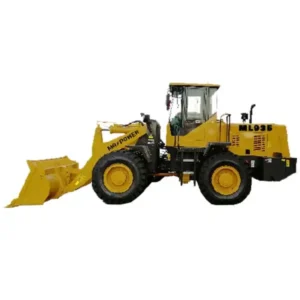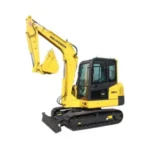Introduction
Wheel loaders are versatile and efficient machines used in a wide range of industries, from construction and mining to agriculture and landscaping. These powerful pieces of equipment play a crucial role in material handling, loading, and transportation tasks. With so many different types of wheel loaders available, it’s essential to understand the key features and capabilities of each to make an informed decision that best suits your specific needs. In this comprehensive blog post, we’ll explore the various types of wheel loaders, their unique characteristics, and how to choose the right one for your project.
Understanding the Different Types of Wheel Loaders

Wheel loaders come in a variety of sizes, configurations, and specifications, each designed to address different applications and job site requirements. Here’s a closer look at the main types of wheel loaders:
Standard Wheel Loaders
Standard wheel loaders are the most common and widely used type of wheel loader. These machines are known for their impressive lift capacities, powerful engines, and versatility in handling a wide range of materials. They are often used in construction, mining, quarrying, and large-scale material handling operations.
Compact Wheel Loaders
Compact wheel loaders are smaller and more maneuverable compared to their standard counterparts. These machines are ideal for applications in tight spaces, such as urban construction sites, landscaping projects, and small-scale material handling. Compact wheel loaders typically have a lower operating weight and reduced dimensions, making them more agile and easily transported.
Articulated Wheel Loaders
Articulated wheel loaders feature a unique design with a hinged joint between the front and rear frames, allowing for greater maneuverability and improved stability on uneven terrain. These loaders are often used in construction, forestry, and waste management applications where the ability to navigate through narrow spaces and over rough ground is essential.
Skid-Steer Wheel Loaders
Skid-steer wheel loaders are known for their compact size, high power-to-weight ratio, and excellent maneuverability. These loaders are particularly useful in applications where tight spaces, low-clearance areas, and the ability to make tight turns are required, such as in the construction, landscaping, and industrial sectors.
Specialized Wheel Loaders
In addition to the primary types mentioned above, there are also specialized wheel loaders designed for specific applications. These may include high-lift wheel loaders for increased reach and loading height, waste handling wheel loaders with specialized attachments, and agricultural wheel loaders optimized for use in farm and rural environments.
Factors to Consider When Choosing a Wheel Loader
When selecting a wheel loader for your project, it’s important to consider several key factors to ensure you choose the right machine for the job. These factors include:
Job Site Requirements: Assess the size, terrain, and material handling needs of your job site. This will help you determine the appropriate size, power, and features of the wheel loader.
Load Capacity and Lift Height: Evaluate the maximum load capacity and lift height required for your application, as these specifications will vary across different wheel loader models.
Fuel Efficiency and Emissions: Consider the fuel efficiency and emissions standards of the wheel loader, especially if you’re operating in environmentally sensitive areas or have sustainability goals.
Operator Comfort and Safety: Look for features that prioritize operator comfort, such as ergonomic controls, climate control, and advanced safety systems.
Maintenance and Serviceability: Assess the ease of maintenance and accessibility of key components to ensure efficient and cost-effective upkeep of the wheel loader.
Budget and Total Cost of Ownership: Determine your budget and consider the overall cost of ownership, including purchase price, fuel consumption, maintenance, and operational costs.
Comparison: Types of Wheel Loader

To help you better understand the differences between the various wheel loader types, we’ve compiled the following comparison table:
| Fonctionnalité | Standard Wheel Loader | Compact Wheel Loader | Articulated Wheel Loader | Skid-Steer Wheel Loader |
|---|---|---|---|---|
| Typical Operating Weight | 15,000 – 50,000 lbs | 5,000 – 15,000 lbs | 15,000 – 45,000 lbs | 3,000 – 8,000 lbs |
| Lift Capacity | 5,000 – 20,000 lbs | 2,000 – 6,000 lbs | 5,000 – 15,000 lbs | 1,500 – 3,500 lbs |
| Hauteur de levage | 12 – 20 ft | 8 – 12 ft | 12 – 18 ft | 8 – 12 ft |
| Engine Power | 100 – 400 hp | 50 – 100 hp | 100 – 300 hp | 50 – 90 hp |
| Maniabilité | Good | Excellent | Excellent | Excellent |
| Typical Applications | Construction, mining, quarrying, material handling | Landscaping, small-scale construction, material handling in tight spaces | Construction, forestry, waste management, material handling | Construction, landscaping, industrial, material handling in tight spaces |
Conclusion: Types of Wheel Loader
Selecting the right type of chargeuse sur pneus for your needs is crucial for the success of your project. By understanding the various types of wheel loaders, their features, and the key factors to consider, you can make an informed decision that will optimize your material handling operations, improve efficiency, and ensure the safety of your workforce. Whether you’re working on a large-scale construction site, a small-scale landscaping project, or anything in between, there’s a wheel loader solution that can meet your specific requirements.
FAQ
What are the main differences between compact, medium, and large wheel loaders?
Compact loaders are smaller and more maneuverable, while large loaders offer higher power and lifting capacity for heavy-duty operations. Medium loaders strike a balance between size and versatility.
How can I determine which wheel loader size is suitable for my project?
Consider factors such as project scale, space constraints, and required lifting capacity. Compact loaders are ideal for urban settings, while large loaders are suitable for large-scale projects like mining and quarrying.
Quels accessoires peuvent être utilisés avec les chargeuses sur pneus ?
Common attachments include buckets, forks, grapples, and snow blades. Compatibility with attachments varies by loader type and manufacturer specifications.
What maintenance practices are essential for wheel loaders?
Regular inspections, lubrication, and timely servicing are critical to maintaining optimal performance and extending the lifespan of wheel loaders.
How do fuel efficiency and operating costs differ between compact, medium, and large wheel loaders?
Compact loaders typically have higher fuel efficiency due to smaller engines, while large loaders may consume more fuel but offer higher productivity in heavy-duty applications.








-150x150.webp)
